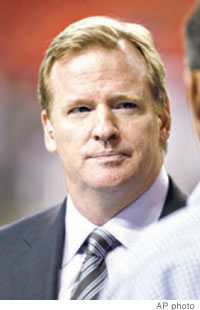NFL Owners, Players Self-destructing

Wednesday - December 08, 2010
| Share
 Del.icio.us
Del.icio.us
|
The NFL and Players Association are four months away from a lockout, and even farther from any deadline that would force the league to cancel games, but the outlook for labor peace seems less likely with each snide remark and finger pointed.
Even if a deal is reached soon enough to save the season, millions in revenue is likely to be lost.
According to an Oct. 13 article in The Wall Street Journal, the league could lose $1 billion even if an agreement is signed by mid-summer.
This number has been contested. Marc Ganis, a sports marketing consultant who was interviewed by USA Today in an article about NFL Players Association president Kevin Mawae, said $500 million in losses is a more accurate estimate.
Whatever the real figures are, the bite both sides will take is very real. Sponsors are already voicing concerns about the possibility of lost games.
EA Sports is in talks with the league to reduce its payment schedule to the NFL by $30 million.
Citing people familiar with a financial report circulated at the owners’ annual fall meeting, the Journal reports that existing corporate sponsors will demand discounts totaling $120 million if an agreement isn’t reached by March 1.
Of the two sides, the NFL is in a stronger financial position, since its agreement with the television networks guarantees payment whether or not games are played. But this is a short-term solution, since the money would have to be refunded at a later date. This complicates matters even more, since the league, according to the Journal article, and its teams are carrying about $8.5 billion in long-term debt - much of this because of the spate of new stadiums that have been built in recent years.
And while the financial losses are relatively easy to determine, the effects of a lockout on ticket sales are much harder to determine. What we do know is that regardless of sport, work stoppages are typically followed by reduced ticket sales.
It would be a big mistake to assume the league is too big to fail with fans. The NFL is the world’s wealthiest sports league, with each team ranking in Forbes.com’s list of the 50 most-valuable sports franchises, but just two decades ago things were much different.
In 1984, Sports Illustrated‘s William Taafe, in a side-bar to Paul Zimmerman’s piece on how to revive the NFL, reported that in just three years, television ratings took a nose dive by as much as 18.2 percent (on CBS) from an all-time high in 1981. Even the venerable Monday Night Football lost 25 percent of its viewers during the same period.
While the falling ratings were a disaster for the league, it was great news for advertisers who no longer had to pay whatever the networks demanded. Thirty-second spots on CBS were selling for as little as $75,000, even though its rate card called for twice that amount. Things had gotten so bad that Miller and Chevrolet, two staples of football advertising, even deserted the Super Bowl.
The NFL acknowledges the animosity will just make coming to an agreement more difficult.
“People think we can have a knock-down drag-out fight and settle on March 1, and everything will be fine, and it’s not true,” said Eric Grubman, the league’s executive vice president for finance in the Journal article. Yet the hostility is as open as the condescending remarks.
Speaking to the Bloomberg News Service in May, Dallas Cowboys owner Jerry Jones said the cost of building and running a modern stadium must be considered when determining the division of revenues as part of any new labor agreement. Jones makes a sound argument, but costs himself credibility by then talking down to the players. “I built a stadium and that stadium costs money,” he said. “We need to recognize that it’s good for the players, it’s good for the fans, it’s good for everybody ... Think, if you were a player, how neat it would be to run in there and compete in that stadium. Three-hundred feet tall, 3 million square feet. Well, guys, we’ve got to pay for that.”
It also may not help that Mawae put the blame on the owners and their individual greed.
“The bigger issue is that Jerry Jones doesn’t want to share his money with (the Buffalo Bills’ Ralph Wilson). (Washington Redskins owner) Daniel Snyder doesn’t want to float (the Cincinnati Bengals’) Mike Brown. Instead of them figuring out their revenue-sharing problem ... they throw it into the laps of the players.”
Perhaps it is time for both sides to look for a different solution to their problems.
Peter Kupelian, a lawyer with Kupelian Ormond & Magy, a Michigan-based law firm, says the fledgling business of sports mediation could be an effective alternative to the standard negotiations that have taken place. In a 2009 essay on the company’s website, Kupelian writes that mediation is specifically suited to professional sports since the use of a neutral third party can help both sides identify key issues, preserve working relationships and provide the flexibility to change negotiations styles as warranted. The American Arbitration Association reports an 80 percent settlement rate for all cases that participate in its mediation program.
It’s worth a shot. What do they have to lose but a billion dollars?
E-mail this story | Print this page | Comments (0) | Archive | RSS Comments (0) |
Most Recent Comment(s):













